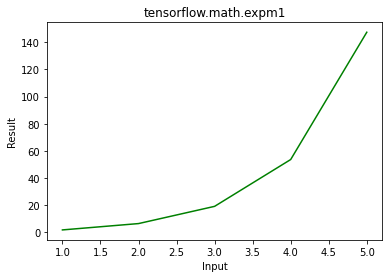TensorFlow es una biblioteca Python de código abierto diseñada por Google para desarrollar modelos de aprendizaje automático y redes neuronales de aprendizaje profundo.
expm1() se utiliza para calcular elementos sabios exp(x)-1.
Sintaxis: tensorflow.math.expm1(x, nombre)
Parámetros:
- x: Es el tensor de entrada. Los dtypes permitidos son bfloat16, half, float32, float64, complex64, complex128.
- name(opcional): Define el nombre de la operación.
Devoluciones: Devuelve un tensor del mismo tipo que x.
Ejemplo 1:
Python3
# importing the library
import tensorflow as tf
# Initializing the input tensor
a = tf.constant([1, 2, 3, 4, 5], dtype = tf.float64)
# Printing the input tensor
print('Input: ', a)
# Calculating result
res = tf.math.expm1(x = a)
# Printing the result
print('Result: ', res)
Producción:
Input: tf.Tensor([1. 2. 3. 4. 5.], shape=(5, ), dtype=float64) Result: tf.Tensor([ 1.71828183 6.3890561 19.08553692 53.59815003 147.4131591 ], shape=(5, ), dtype=float64)
Ejemplo 2: Visualización
Python3
# importing the library
import tensorflow as tf
import matplotlib.pyplot as plt
# Initializing the input tensor
a = tf.constant([1, 2, 3, 4, 5], dtype = tf.float64)
# Calculating result
res = tf.math.expm1(x = a)
# Plotting the graph
plt.plot(a, res, color ='green')
plt.title('tensorflow.math.expm1')
plt.xlabel('Input')
plt.ylabel('Result')
plt.show()
Producción:

Publicación traducida automáticamente
Artículo escrito por aman neekhara y traducido por Barcelona Geeks. The original can be accessed here. Licence: CCBY-SA